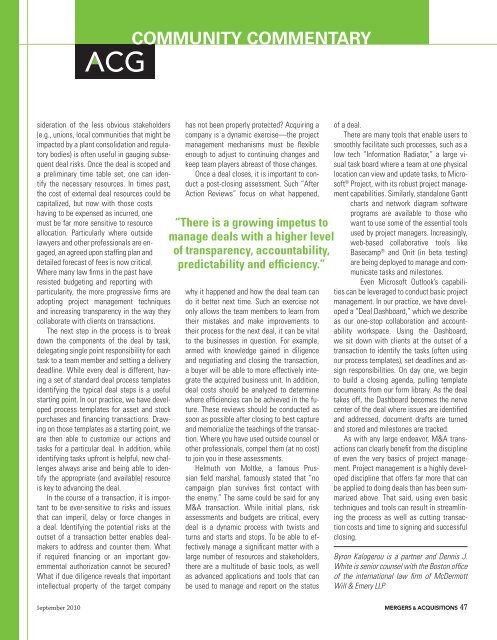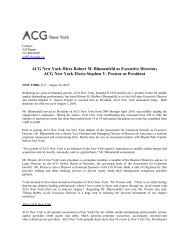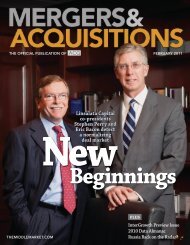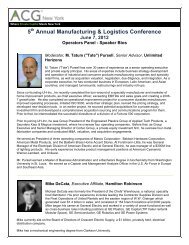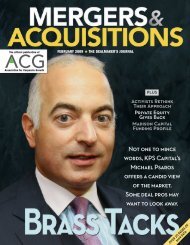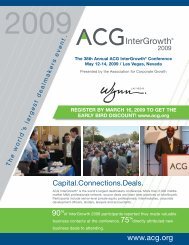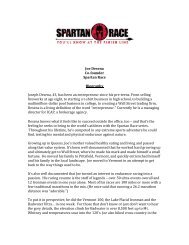September 2010 - Association for Corporate Growth
September 2010 - Association for Corporate Growth
September 2010 - Association for Corporate Growth
Create successful ePaper yourself
Turn your PDF publications into a flip-book with our unique Google optimized e-Paper software.
COMMUNITY COMMENTARY<br />
sideration of the less obvious stakeholders<br />
(e.g., unions, local communities that might be<br />
impacted by a plant consolidation and regulatory<br />
bodies) is often useful in gauging subsequent<br />
deal risks. Once the deal is scoped and<br />
a preliminary time table set, one can identify<br />
the necessary resources. In times past,<br />
the cost of external deal resources could be<br />
capitalized, but now with those costs<br />
having to be expensed as incurred, one<br />
must be far more sensitive to resource<br />
allocation. Particularly where outside<br />
lawyers and other professionals are engaged,<br />
an agreed upon staffing plan and<br />
detailed <strong>for</strong>ecast of fees is now critical.<br />
Where many law firms in the past have<br />
resisted budgeting and reporting with<br />
particularity, the more progressive firms are<br />
adopting project management techniques<br />
and increasing transparency in the way they<br />
collaborate with clients on transactions.<br />
The next step in the process is to break<br />
down the components of the deal by task,<br />
delegating single point responsibility <strong>for</strong> each<br />
task to a team member and setting a delivery<br />
deadline. While every deal is different, having<br />
a set of standard deal process templates<br />
identifying the typical deal steps is a useful<br />
starting point. In our practice, we have developed<br />
process templates <strong>for</strong> asset and stock<br />
purchases and financing transactions. Drawing<br />
on those templates as a starting point, we<br />
are then able to customize our actions and<br />
tasks <strong>for</strong> a particular deal. In addition, while<br />
identifying tasks upfront is helpful, new challenges<br />
always arise and being able to identify<br />
the appropriate (and available) resource<br />
is key to advancing the deal.<br />
In the course of a transaction, it is important<br />
to be ever-sensitive to risks and issues<br />
that can imperil, delay or <strong>for</strong>ce changes in<br />
a deal. Identifying the potential risks at the<br />
outset of a transaction better enables dealmakers<br />
to address and counter them. What<br />
if required financing or an important governmental<br />
authorization cannot be secured?<br />
What if due diligence reveals that important<br />
intellectual property of the target company<br />
has not been properly protected? Acquiring a<br />
company is a dynamic exercise—the project<br />
management mechanisms must be flexible<br />
enough to adjust to continuing changes and<br />
keep team players abreast of those changes.<br />
Once a deal closes, it is important to conduct<br />
a post-closing assessment. Such “After<br />
Action Reviews” focus on what happened,<br />
“There is a growing impetus to<br />
manage deals with a higher level<br />
of transparency, accountability,<br />
predictability and efficiency.”<br />
why it happened and how the deal team can<br />
do it better next time. Such an exercise not<br />
only allows the team members to learn from<br />
their mistakes and make improvements to<br />
their process <strong>for</strong> the next deal, it can be vital<br />
to the businesses in question. For example,<br />
armed with knowledge gained in diligence<br />
and negotiating and closing the transaction,<br />
a buyer will be able to more effectively integrate<br />
the acquired business unit. In addition,<br />
deal costs should be analyzed to determine<br />
where efficiencies can be achieved in the future.<br />
These reviews should be conducted as<br />
soon as possible after closing to best capture<br />
and memorialize the teachings of the transaction.<br />
Where you have used outside counsel or<br />
other professionals, compel them (at no cost)<br />
to join you in these assessments.<br />
Helmuth von Moltke, a famous Prussian<br />
field marshal, famously stated that “no<br />
campaign plan survives first contact with<br />
the enemy.” The same could be said <strong>for</strong> any<br />
M&A transaction. While initial plans, risk<br />
assessments and budgets are critical, every<br />
deal is a dynamic process with twists and<br />
turns and starts and stops. To be able to effectively<br />
manage a significant matter with a<br />
large number of resources and stakeholders,<br />
there are a multitude of basic tools, as well<br />
as advanced applications and tools that can<br />
be used to manage and report on the status<br />
of a deal.<br />
There are many tools that enable users to<br />
smoothly facilitate such processes, such as a<br />
low tech “In<strong>for</strong>mation Radiator,” a large visual<br />
task board where a team at one physical<br />
location can view and update tasks, to Microsoft<br />
® Project, with its robust project management<br />
capabilities. Similarly, standalone Gantt<br />
charts and network diagram software<br />
programs are available to those who<br />
want to use some of the essential tools<br />
used by project managers. Increasingly,<br />
web-based collaborative tools like<br />
Basecamp ® and Onit (in beta testing)<br />
are being deployed to manage and communicate<br />
tasks and milestones.<br />
Even Microsoft Outlook’s capabilities<br />
can be leveraged to conduct basic project<br />
management. In our practice, we have developed<br />
a “Deal Dashboard,” which we describe<br />
as our one-stop collaboration and accountability<br />
workspace. Using the Dashboard,<br />
we sit down with clients at the outset of a<br />
transaction to identify the tasks (often using<br />
our process templates), set deadlines and assign<br />
responsibilities. On day one, we begin<br />
to build a closing agenda, pulling template<br />
documents from our <strong>for</strong>m library. As the deal<br />
takes off, the Dashboard becomes the nerve<br />
center of the deal where issues are identified<br />
and addressed, document drafts are turned<br />
and stored and milestones are tracked.<br />
As with any large endeavor, M&A transactions<br />
can clearly benefit from the discipline<br />
of even the very basics of project management.<br />
Project management is a highly developed<br />
discipline that offers far more that can<br />
be applied to doing deals than has been summarized<br />
above. That said, using even basic<br />
techniques and tools can result in streamlining<br />
the process as well as cutting transaction<br />
costs and time to signing and successful<br />
closing.<br />
Byron Kalogerou is a partner and Dennis J.<br />
White is senior counsel with the Boston office<br />
of the international law firm of McDermott<br />
Will & Emery LLP<br />
<strong>September</strong> <strong>2010</strong> MERGERS & ACQUISITIONS 47


